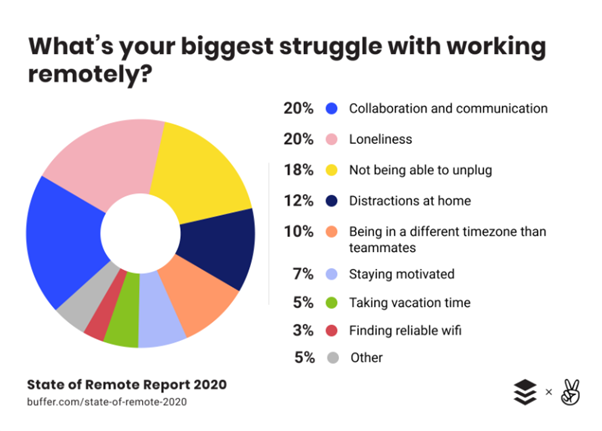Remote working is here to stay:
How to manage your team successfully
The pandemic has taken most businesses from busy offices to individual working. Just recently it was announced the drastic reduction of workers in Canary Wharf. On the last working day of February just 19,282 people passed through Canary Wharf station, according to Transport for London (TfL) figures, down from 110,609 on the same day last year.
Several other organisations based in the area have downsized both from redundancies and remote working. One includes Fintech business Revolut, who have told their 800 London staff they come in as and when they choose and that they can spend up to two months of the year working abroad too, should they wish.
This is becoming an increasingly common scenario. A recent survey by Gartner revealed remote working looks set to become permanent for up to over two-thirds (74%), who plan to permanently shift employees to remote work after the Covid-19 crisis ends.
Remote working can have many benefits for businesses. From a wider talent pool, to increase productivity and a better work life balance. But not having the right strategy can be detrimental to organisations.
Here are some tips to nailing your remote working strategy.
Combat remote working loneliness
Working from home fulltime can be an incredibly lonely experience for some. To go from working in a busy office, to a room alone can be a tough transition.
Just chatting over a coffee or going for walk over lunch can be critical in building connections and providing a small relief from work which helps improve wellbeing and general mood. When these little interactions are removed, this can be isolating. According to the 2020 State of Remote Work Report, nearly 20% of remote workers say they struggle with loneliness when remote working.

How can this be combated?
When managing a remote team, it’s important to create opportunities for employees to reconnect with each other. This can include team quizzes, online exercise classes or just a general catch up. If you’re not sure what your team want, a great way to find out is to send out a survey to find out what people want.
Communication is key
At the centre of a successful remote working strategy is good and frequent communication. From onboarding your remote workforce to the allocation of tasks, without good communication, miscommunication is likely.
Your remote working strategy should include a thorough onboarding experience which should allow enough time for the candidate to get to know the organisations thoroughly and feel welcomed by the team.
In a full office, it’s easy to turn around and speak to a manager or fellow employee about work and get clarity over tasks. But, in the siloed environment with no direct face to face interaction, a small question can feel like an unnecessary interruption to a person’s day. So, it’s important to communicate with the team regularly and ensure any questions or issues are ironed out. Employees need to feel like they can come to their managers with any questions.
Great apps for communication include Teams, Slack and Trello. However alongside this, it’s important managers schedule in time to speak to their team and check their mood, workload, and generally how they’re managing their situation. It is also important to encourage open communication whenever they feel is necessary, so there is not the ‘but I don’t want to disturb someone’ mindset.
Encourage a work-life balance
As important as productivity is, having a good work-life balance is not always easy when your workspace is in the same space as your place to relax. As a result, working from home can cause wellbeing to be negatively impacted through burnout. Before lockdown, there was a worry that those working remotely worked less hours. But in fact, many often ended up working longer hours than when they were in the office. As part of the remote working strategy, it’s important remote employees are reminded of the importance of taking breaks, rather than having to be constantly ‘always available.’
How can this be combatted?
Employees should be reminded that they can be clear when taking breaks. Many apps allow the changing of a status to ‘offline’ or by blocking out time in a work schedule. This helps inform other staff members that someone is away and will not be responding.
As mentioned earlier, it’s also important to keep track of employee workload to ensure too much pressure isn’t being put on teams.
Ensure strong company culture and values
Company culture is at the heart of a business. It is the values, ideals, and goals of the organisation. But, when working remotely, it can be challenging to continue to communicate and reflect these clearly to employees. A good remote working strategy will have these values ingrained within both external and internal communications.
Some ways to help improve company culture in a remote team could include:
- Encouragement of open conversation between teams. Frequent check ins frequently with colleagues and teams to have calls purely for the purpose of ‘catching up’. These can help teams feel connected and less isolated.
- To encourage employees to stay active, competitions could be run between departments based on how many miles they swim/cycle/run etc using the app Strava. This helps encourage communication between other teams and helps motivate staff to exercise for benefits outside of their own fitness!
- Ensure recognition for good work is given, even if that’s simply verbally acknowledging that a particular piece of work has been well received. Showing appreciation will help staff remain motivated.

Having good company culture is massively beneficial for both employee acquisition and retention. In fact, 65% of employees say that their company’s culture is a key factor when deciding to stay at their job. Further to this, 56% of employees find a good workplace culture to be more important than salary. So, when refining your remote working strategy, good company culture should come high on the priority list for improvement.
Managing a remote workforce
Despite lockdown restrictions easing (slowly), remote working looks here to stay. Managing a remote global workforce comes with many challenges. But with a PEO, they can help you deal with all the compliance, HR admin and payroll and tax tasks that come with it. Get in touch with a member of our team today to find out how we can help.
